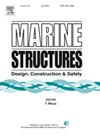轴向拉伸和弯曲载荷作用下船用动力电缆螺旋动力芯部件的应力分析和摩擦行为
IF 5.1
2区 工程技术
Q1 ENGINEERING, CIVIL
引用次数: 0
摘要
随着海上风能开发的不断增加,动态电缆的利用变得至关重要。螺旋动力芯部件是海洋动力电缆中必不可少的功能部件,了解这些螺旋结构在复杂外部载荷下的力学行为已经引起了人们的广泛关注。介绍了动力电缆中螺旋动力芯部件在轴向拉伸和弯曲载荷作用下的综合应力分析模型。与以往的简化模型不同,本文提出的方法完全考虑了导体配置中的双螺旋结构。通过引入包含两个曲率和一个扭转的达布向量,建立了单螺旋和双螺旋导线在拉力和弯曲复合载荷作用下的力学响应模型。该研究进一步深入研究了局部摩擦接触与螺旋结构几何特性之间的相互作用,从而建立了螺旋部件接触应力的解析模型。此外,基于力-反作用原理,提出了螺旋动力芯的多层压力传递模型。为了考虑摩擦力,将库仑摩擦定律融入模型,并提供迭代求解过程以获得摩擦滑移结果。利用有限元模拟和现有实验数据对理论模型进行了验证,并具体应用于高压直流电缆。结果表明,该模型在预测非线性拉弯矩组合作用下的截面应力方面是准确的。该工作为复杂载荷条件下海洋动力电缆的分析和设计提供了有价值的技术支持,有助于优化其力学性能。本文章由计算机程序翻译,如有差异,请以英文原文为准。
Stress analysis and frictional behavior of helical power core components in marine dynamic cables under axial tension and bending loads
As the development of offshore wind energy continues increasing, the utilization of dynamic cables becomes crucial. Helical power core components are essential functional elements in marine dynamic cables, and understanding the mechanical behavior of these spiral structures under complex external loads has garnered significant attention. This study introduces a comprehensive stress analysis model for helical power core components in dynamic cables subjected to axial tension and bending loads. Unlike previous simplified models, the proposed approach fully accounts for the double-helix structure in the conductor configuration. By introducing Darboux vectors, which encompass two curvatures and one twist, the mechanical response models for both single-helix and double-helix conductor wires under combined tension and bending loads are developed. The study further delves into the interactions between local frictional contact and the geometric characteristics of the helical structure, leading to the formulation of analytical models for contact stresses in helical components. Additionally, a multi-layer pressure transmission model for the helical power core is proposed based on the force action-reaction principle. To account for frictional forces, Coulomb’s friction law is integrated into the model, and an iterative solution procedure is provided to obtain friction-slip results. The theoretical model is verified using finite element (FE) simulations and existing experimental data, specifically applied to a high-voltage direct current (HVDC) cable. The results demonstrate the accuracy of the model in predicting cross-sectional stresses under nonlinear combined tension and bending moments. This work offers valuable technical support for the analysis and design of marine dynamic cables under complex loading conditions, contributing to the optimization of their mechanical performance.
求助全文
通过发布文献求助,成功后即可免费获取论文全文。
去求助
来源期刊

Marine Structures
工程技术-工程:海洋
CiteScore
8.70
自引率
7.70%
发文量
157
审稿时长
6.4 months
期刊介绍:
This journal aims to provide a medium for presentation and discussion of the latest developments in research, design, fabrication and in-service experience relating to marine structures, i.e., all structures of steel, concrete, light alloy or composite construction having an interface with the sea, including ships, fixed and mobile offshore platforms, submarine and submersibles, pipelines, subsea systems for shallow and deep ocean operations and coastal structures such as piers.
 求助内容:
求助内容: 应助结果提醒方式:
应助结果提醒方式:


